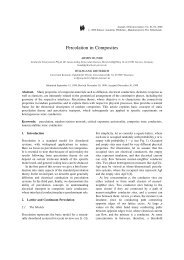Emplacement depths and radiometric ages of Paleozoic plutons of ...
Emplacement depths and radiometric ages of Paleozoic plutons of ...
Emplacement depths and radiometric ages of Paleozoic plutons of ...
You also want an ePaper? Increase the reach of your titles
YUMPU automatically turns print PDFs into web optimized ePapers that Google loves.
236<br />
Table 2<br />
Analytical data <strong>of</strong> K–Ar age determinations on biotite <strong>and</strong> hornblende. Argon concentrations in nanoliter per gram at st<strong>and</strong>ard conditions (nl/g<br />
STP); potassium concentrations in weight percentage (wt.%)<br />
Sample Locality Mineral Fraction (Am) K (wt.%) Radiogenic Ar Date (Ma)<br />
(nl/g STP) (%)<br />
PAM27F Hoher–Stein biotite 125–63 6.75 98.89 99.1 342 F 4<br />
113 quarry Smrzˇovice biotite 250–125 6.94 153.80 98.8 495 F 6<br />
SK4 quarry Smrzˇovice hornblende 125–63<br />
(magnetic fraction)<br />
0.26 6.49 91.7 547 F 7<br />
SK4 quarry Smrzˇovice hornblende 125–63<br />
(unmagnetic fraction)<br />
0.27 6.81 91.9 549 F 7<br />
Mean st<strong>and</strong>ard deviation (2r) <strong>of</strong> radiogenic argon is about 0.3% <strong>and</strong> <strong>of</strong> potassium about 1% for high-K <strong>and</strong> low-K materials, respectively. The<br />
error in the K –Ar apparent age is given at the 95% confidence level. Note that our K–Ar date for the st<strong>and</strong>ard glauconite GL-O is about 1%<br />
younger than the mean value <strong>of</strong> the compilation <strong>of</strong> Odin (1982).<br />
dip–slip or slightly oblique-slip lineation portrayed<br />
by stretched plagioclase or by the long axes <strong>of</strong><br />
amphibole. Non-coaxial top–down-to-the-NE normal<br />
movements are indicated by asymmetric amphibole<br />
porphyroclasts (j- <strong>and</strong> y-clasts) <strong>and</strong> by shear b<strong>and</strong><br />
fabrics (see Table 1A in Bues et al., 1998).<br />
5. Depth <strong>of</strong> pluton emplacement<br />
Using the geothermometers <strong>and</strong> geobarometers<br />
mentioned above <strong>and</strong> shown in Fig. 6, we calculated<br />
the following temperatures <strong>and</strong> pressures. For granodiorite<br />
<strong>and</strong> quartz diorite <strong>of</strong> the Vsˇepadly <strong>and</strong><br />
Smrzˇovice intrusion, the equilibration temperatures<br />
<strong>of</strong> hornblende <strong>and</strong> plagioclase are in the range <strong>of</strong><br />
Fig. 7. Cathodoluminescence image <strong>of</strong> a zircon separated from the<br />
Teufelsberg diorite (for further explanation, see text).<br />
C. Bues et al. / Tectonophysics 352 (2002) 225–243<br />
620–680 jC (Fig. 6A <strong>and</strong> B). Low crystallization<br />
pressures <strong>of</strong> hornblende (1.5–3 kbar; Fig. 6A <strong>and</strong> B)<br />
indicate emplacement at shallow crustal levels. Higher<br />
equilibration temperatures <strong>of</strong> 830–920 jC were calculated<br />
for pyroxene diorite <strong>of</strong> the Smrzˇovice, Vsˇeruby,<br />
<strong>and</strong> Teufelsberg intrusion (Fig. 6C <strong>and</strong> E) that do<br />
not show the appropriate mineral assemblage for<br />
using the Al-in-Hbl barometry. For the Smrzˇovice<br />
pyroxene diorite, the pressure should be similar to<br />
that <strong>of</strong> the quartz diorite from the same locality. For<br />
the Vsˇeruby <strong>and</strong> Teufelsberg pyroxene diorite, we<br />
have inferred the pressure from the corona micr<strong>of</strong>abrics<br />
that occur in the associated olivine gabbros<br />
(see below). Ortho- <strong>and</strong> clinopyroxene equilibration<br />
temperatures up to 980–1080 jC have been derived<br />
from olivine gabbro <strong>and</strong> gabbronorite <strong>of</strong> the Vsˇeruby<br />
intrusion (Fig. 6D). Equilibration temperatures <strong>of</strong><br />
reaction rims between olivine <strong>and</strong> plagioclase are<br />
Fig. 8. Concordia diagram for zircons from the Teufelsberg diorite<br />
(locality Hoher–Stein).



